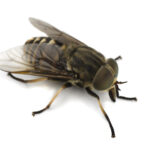Wild turkeys, unlike their domesticated counterparts, possess the remarkable ability to take to the skies, albeit in short bursts. While they might not be soaring eagles, understanding how high wild turkeys fly reveals fascinating aspects of their survival strategies and natural behaviors. These birds, commonly observed foraging on the ground, actually rely on flight for crucial aspects of their lives, particularly for safety and roosting.
To truly appreciate the flight capabilities of wild turkeys, we need to delve into the specifics of their aerial maneuvers. While “flightless” might be the first word that comes to mind when considering a turkey’s bulky physique, the reality is quite different for wild turkeys in their natural habitats.
Understanding Wild Turkey Flight Capabilities
Wild turkeys are not built for sustained, long-distance flight like migratory birds. Instead, their bodies are adapted for powerful, rapid ascents. Think of it as a sprinter versus a marathon runner. Wild turkeys are sprinters of the avian world when it comes to flight. They utilize their strong leg muscles and broad wings to launch themselves upwards with surprising speed and agility. This burst flight is essential for escaping predators quickly or reaching the safety of elevated roosting spots.
How High Do Wild Turkeys Typically Fly?
When it comes to altitude, wild turkeys are low-altitude fliers. Their primary goal in flight isn’t to reach great heights, but rather to gain enough elevation to access tree branches for roosting or to put a safe distance between themselves and ground-based threats. Wild turkeys typically fly to heights of around 15 meters (50 feet) to reach their preferred roosting branches. This height allows them to settle comfortably on the sturdy, primary branches of mature trees, offering protection from nighttime predators like foxes, coyotes, and bobcats.
However, not every roosting spot is at the maximum height. Wild turkeys are also known to utilize lower branches, often between 6 and 9 meters (20-30 feet) off the ground, especially if they find a secure and suitable branch lower down. The key factor is finding a branch that is strong enough to support their weight and provides adequate cover. They are pragmatic birds, choosing efficiency and safety over unnecessary altitude.
Factors Influencing Wild Turkey Flight Height
Several factors can influence how high a wild turkey might fly in a given situation:
- Tree Type and Branch Structure: Wild turkeys prefer trees with broad, horizontal branches like oaks, sycamores, and cottonwoods. The availability of suitable branches at different heights in these trees will dictate their roosting altitude.
- Predator Pressure: If a turkey is startled by a predator, it might fly higher to put more distance between itself and the threat. However, even in escape flights, they rarely ascend to extreme altitudes, focusing on reaching the nearest safe perch.
- Terrain and Environment: In more open habitats, turkeys might choose slightly higher roosting spots for better visibility and predator detection. In denser forests, lower roosting spots within the canopy might suffice.
- Weather Conditions: While not directly related to height, strong winds or heavy rain can affect a turkey’s flight and roosting choices. They will generally seek sheltered roosting locations, which might influence the height they choose within a tree.
Comparing Wild Turkey Flight to Domestic Turkeys
The contrast between wild and domestic turkeys highlights the impact of domestication. Domestic turkeys have been selectively bred for meat production, resulting in larger breast muscles and heavier bodies. This breeding process has inadvertently diminished their flight capabilities. Domestic turkeys are essentially flightless due to their weight and underdeveloped wings, as they no longer need to escape predators or forage in the wild for survival. They are provided with food and shelter, removing the evolutionary pressure to maintain flight proficiency.
Other Flight Abilities of Wild Turkeys
While our focus is on flight height, it’s worth noting other aspects of wild turkey flight that contribute to their survival:
- Speed: Wild turkeys can achieve impressive burst speeds in flight, reaching up to 90 km/h (55 mph). This speed is crucial for rapid escape from danger, even if it cannot be sustained for long durations.
- Distance: Wild turkey flights are typically short, with a maximum distance of around 400 meters (just under a quarter of a mile). Their flight is designed for quick relocation, not long journeys.
- Duration: Due to their physiology and glycogen reserves, wild turkeys cannot maintain flight for extended periods. Their flights are short bursts of intense activity, perfectly suited for their needs.
Conclusion
Wild turkeys, while not high-flying masters of the sky, are certainly capable of flight. They utilize this ability strategically, primarily to reach roosting sites in trees at heights up to 15 meters (50 feet) and to escape predators. Their flight is characterized by powerful bursts of speed and agility over short distances and at relatively low altitudes. Understanding how high wild turkeys fly provides valuable insight into their adaptation to their environment and their successful survival in the wild. They are a testament to the diverse ways birds have evolved to utilize flight for their specific ecological niches.
